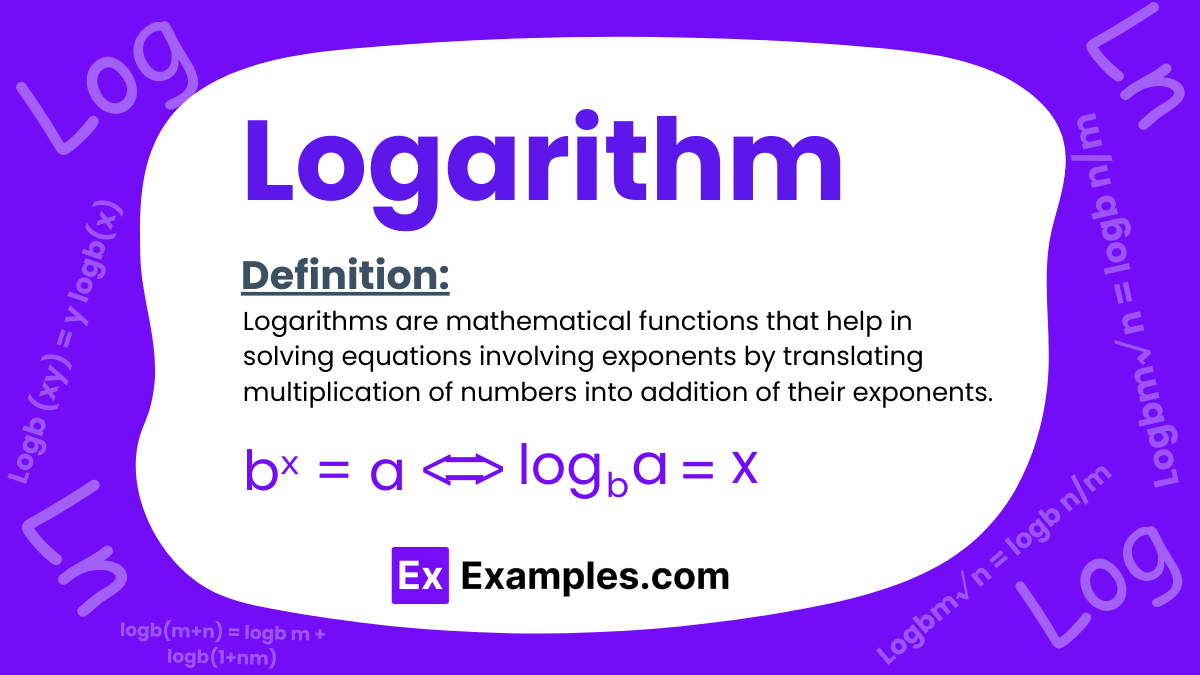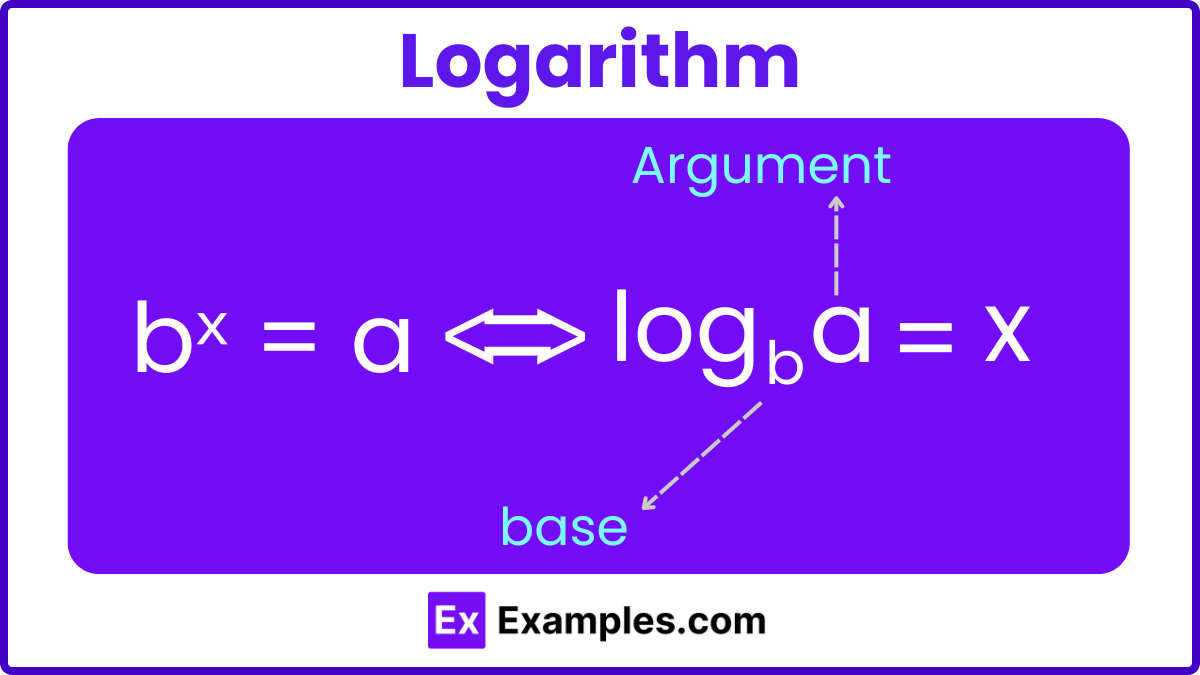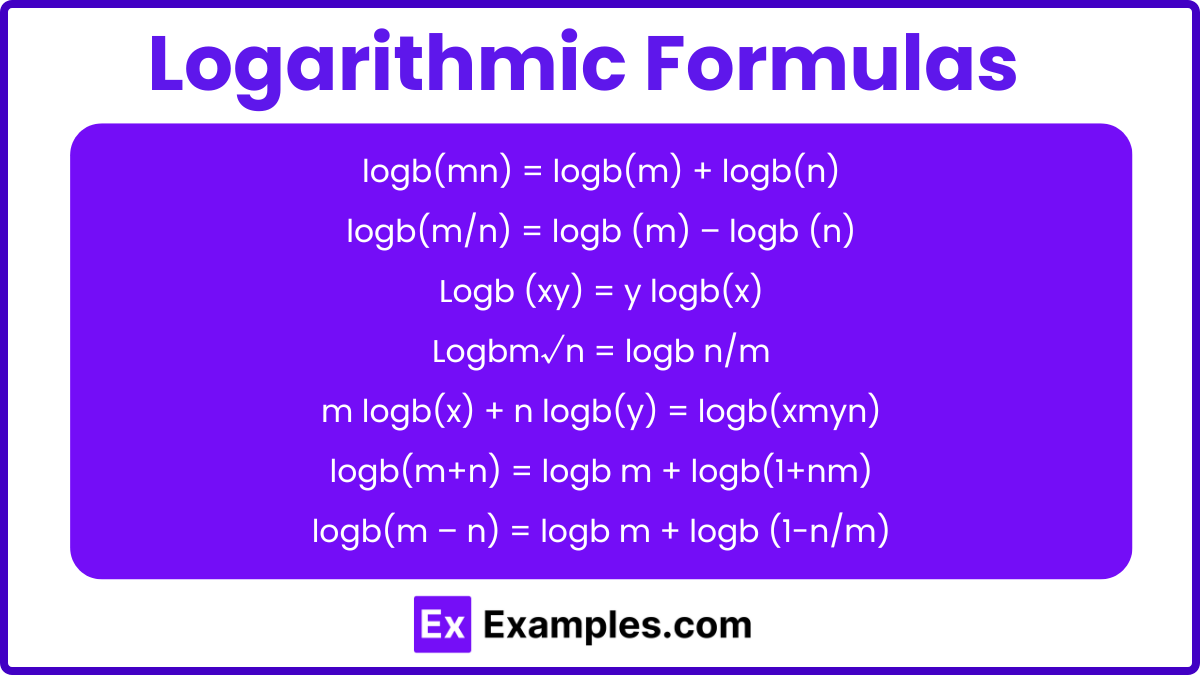What is the value of log₂ 32?
3
4
5
6


Logarithms are mathematical functions that help in solving equations involving exponents by translating multiplication of numbers into addition of their exponents. Essentially, a logarithm asks the question: “To what exponent must one number, called the base, be raised to produce another number?”

Logarithms can be categorized based on their base, which defines the type and use of the logarithm in various mathematical contexts. Here are the three primary types of logarithms, each with its unique applications:
There are certain rules based on which logarithmic operations can be performed. The names of these rules are:
Let us have a look at each of these properties one by one
In this rule, the multiplication of two logarithmic values is equal to the addition of their individual logarithms.
Logb (mn)= logb m + logb n
For example: log3 ( 2y ) = log3 (2) + log3 (y)
The division of two logarithmic values is equal to the difference of each logarithm.
Logb (m/n)= logb m – logb n
For example, log3 ( 2/ y ) = log₃ (2) -log₃ (y)
In the exponential rule, the logarithm of m with a rational exponent is equal to the exponent times its logarithm.
Logb (mⁿ) = n logb m
Example: logb(2³) = 3 logb ²
Logb m = logₐ m/ logₐ b
Example: logb 2 = loga ²/loga b
logb (a) = 1 / loga (b)
Example: logb ⁸ = 1/log8 b
If f (x) = logb (x), then the derivative of f(x) is given by;
f'(x) = 1/(x ln(b))
Example: Given, f (x) = log₁₀(x)
Then, f'(x) = 1/(x ln(10))
∫logb(x)dx = x( logb(x) – 1/ln(b) ) + C
Example: ∫ log₁₀(x) dx = x ∙ ( log₁₀(x) – 1 / ln(10) ) + C
Some other properties of logarithmic functions are:

logb(mn) = logb(m) + logb(n)
logb(m/n) = logb (m) – logb (n)
Logb (xy) = y logb(x)
Logbm√n = logb n/m
m logb(x) + n logb(y) = logb(xmyn)
logb(m+n) = logb m + logb(1+nm)
logb(m – n) = logb m + logb (1-n/m)
| Aspect | Log | Ln |
|---|---|---|
| Full Name | Logarithm | Natural Logarithm |
| Base | Commonly base 10 | Base e (Euler’s Number, approximately 2.71828) |
| Notation | log(𝑥) or log10(𝑥) | ln(𝑥) |
| Usage | Often used in scientific, engineering, and financial calculations involving decimal (base 10) systems. | Predominantly used in mathematics, physics, and engineering to simplify expressions involving growth rates and natural processes. |
| Mathematical Context | log10(𝑥) means 10𝑦=𝑥 | ln(𝑥) means 𝑒𝑦=𝑥 |
| Key Properties | log(10)=1 | ln(𝑒)=1 |
| Application Examples | Decibel levels in sound, pH levels in chemistry, and logarithmic scales used in statistics. | Natural growth and decay processes, calculating time constants in physics, and solving differential equations. |
| Computational Use | Common in general logarithmic calculations without specified base, often assumed base 10. | Essential in exponential growth calculations and when dealing with continuous compound interest. |
| Exponential Form | Logarithmic Form |
|---|---|
| 𝑎𝑏=𝑐 | logₐ𝑐=𝑏 |
| 10³=1000 | log₁₀1000=3 |
| 𝑒𝑥=𝑦 | ln𝑦=𝑥 |
| 2⁴=16 | log₂16=4 |
| 5²=25 | log₅ 25=2 |
| 3−³=1/27 | log₃1/27=−3 |
| 𝑒−¹=1𝑒 | ln1/𝑒=−1 |
| 1000.5=10 | log₁₀₀ 10=0.5 |
Logarithms are fundamental components in mathematics, particularly useful for solving equations involving exponential functions. Among the various types of logarithms, two stand out for their frequent application and inherent properties: the natural logarithm and the common logarithm.
Common Logarithm (log₁₀): Known as the common log, this logarithm uses base 10. It is represented simply as log without any subscript. The common log is particularly useful in computations dealing with scientific notation, as it helps in managing the scale of large numbers, often seen in chemistry and astronomy.
Examples:
Logarithms are primarily algebraic tools used to solve equations involving exponents. They relate to algebraic manipulation of numbers and variables.
A logarithm is a mathematical operation that determines how many times one number, called the base, must be multiplied by itself to obtain another number.
A logarithm helps find the power to which a base number is raised to achieve a certain value. It simplifies dealing with exponential growth or decay.
Logarithms can be challenging due to their abstract nature and the inverse operations they perform, which differ from more intuitive arithmetic operations.
Logarithms are typically introduced in high school, around 9th or 10th grade, often in Algebra II or Pre-Calculus classes.
Yes, logarithms are an integral part of calculus. They are crucial for solving differential equations, integration involving exponential functions, and understanding growth and decay models.
Text prompt
Add Tone
10 Examples of Public speaking
20 Examples of Gas lighting
What is the value of log₂ 32?
3
4
5
6
If log₁₀ x = 3, what is the value of x?
100
1000
10,000
10
What is the value of log₅ 125?
1
2
3
4
Solve logₓ 16 = 4 for x.
2
3
4
5
Find the value of log₃ 81.
1
2
3
4
If log₂ x = 7, what is x?
64
128
256
512
Evaluate log₁₀ 0.01.
-2
-1
1
2
What is log₄ 64?
2
3
4
5
Find log₆ 36.
2
3
4
5
If log₉ x = 1/2, what is x?
3
6
9
81
Before you leave, take our quick quiz to enhance your learning!

